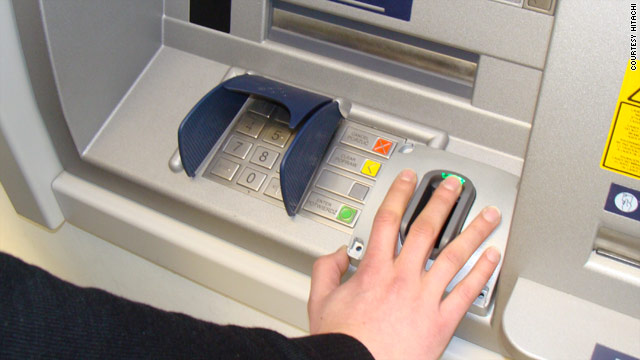George Webster
CNN
July 7, 2010

Poland’s cooperative BPS bank says it’s the first in Europe to install a biometric ATM — allowing customers to withdraw cash simply with the touch of a fingertip.
The digit-scanning ATM, introduced in the Polish capital of Warsaw, runs on the latest in “finger vein” technology — an authentication system developed by Japanese tech giant Hitachi.
The company says that an infrared light is passed through the finger to detect a unique pattern of micro-veins beneath the surface – which is then matched with a pre-registered profile to verify an individual’s identity.
“This is a substantially more reliable technique than using fingerprints,” Peter Jones, Hitachi’s head of security and solutions in Europe, told CNN.
"Our tests indicate there is a one in a million false acceptance rate -- that's as good as iris scanning, which is generally regarded as the most secure method."
Unlike fingerprints, which leave a trace and can be potentially reproduced, finger veins are impossible to replicate, according to Jones, because they are beneath the surface of the skin.
"And before you ask, no -- it doesn't work with fingers that have been chopped off," he added.
While the technology represents a step forward in reducing cases of identity fraud, Jones said that this is just one of many factors that have encouraged the Polish bank to adopt it.
"Here, banks have a responsibility to perform various social functions like dispensing welfare checks and pensions. These cause long queues at the cashier and many people find it inconvenient and even debilitating."
BPS plans to install a biometric ATM at every one of its branches by the end of the year, where, says Jones -- who has worked with the bank for over three years -- they will also function as a collection terminal for state benefits.
Although it is a first for Europe, biometric cash points have been embraced in other parts of the world for some years.
According to business data analysts Bloomberg, the technology became particularly popular in Japan after the passing of legislation in 2006 that made banks liable for withdrawals by criminals using stolen or counterfeit bank cards.
Jones says that there are now over 80,000 biometric ATMs in Japan, currently used by more than 15 million customers.
The machines are also dotted around parts of Asia, Latin America, the Middle East and even parts of Africa -- where, according to banking analyst Stessa Cohen, they are preferred by rural workers living in remote areas, who are not accustomed to carrying bank cards.
So far though, the technology has failed to penetrate banking markets in the West. Cohen, who works for industry analysts Gartner, believes there are a number of data privacy issues that commercial banks have failed to address.
"If these banks are going to make biometrics an attractive proposition, they're going to have to start being much more transparent about what they do with their customer's personal data. They have to show that this type of sensitive information does not belong to them, but to us."
For Jones, however, a driving force behind the lackluster uptake in most western countries is due to a dearth of commercial incentives.
"It's generally the customer who foots the bill for fraud, and the banks have already factored that into their business model. Add to that the fact that it costs thousands of dollars to install a new ATM -- and it's just not worth it from their point of view."
The security and solutions expert believes that Poland's early adoption of biometric ATMs reflects the country's forward-thinking attitude to the role of information technology in society.
"It's no surprise that Poland is the first in Europe. They are one of the most proactive at addressing the challenges of the information age. When they host the EU presidency in 2012, they want to say to the world: 'Look at what we've achieved.'"
The 30 million-strong nation in the heart of Europe boasts one of the fastest growing IT sectors in the region and has placed information technologies at the center of its plan for economic growth over the coming years.
As Kenechi Okeleke, IT and telecom analyst for Business Monitor International, told CNN: "Poland's IT sector has performed really well in recent times. IT is a major focus for the government at the moment and they have adopted an IT Infrastructure Plan with money from the government and the European Union."
Dariusz Piotrowski, development director at Microsoft Poland, says that the key to the country's success in technology is a thriving student body focused on technological innovation.
In July this year Poland will host the Imagine Cup -- a highly competitive global tech competition for students, which regularly enjoys upwards of 300,000 entrants from over 100 countries.
Poland's track-record in the competition has been exemplary.
"They stood on the podium 13 times, taking the first prize five times, second five times and third three times." Piotrowski told CNN. "Polish students have succeeded in the categories such as Algorithm, Short Movie, Game Development, Photography, Embedded Development and Software Design."
And as far as human-computer interaction goes, biometric ATMs are just the tip of the iceberg for students in Poland. Their entry for this year's Software Design category is a project titled "InterPeter" -- a breakthrough system that translates sign language into natural language and vice-versa.